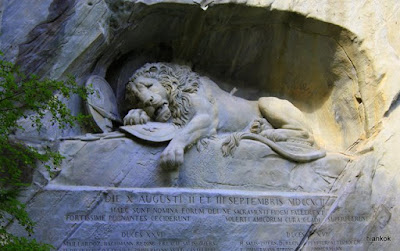This morning we set off for the Hertenstein ship station to catch the 8.58am steamer to Lucerne. We had another lovely and relaxing cruise on the Lake back to Lucerne. We took a train to Engelberg so that we could visit a huge 12th Century Benedictine monastery. The interesting history of Engleberg which means ‘The Mountain of Angel’ is worth a google or wiki trip. It’s yet another scenic train ride from Lucerne to Engelberg. The landscape is very different and the train climbed steeper up the slopes of the Berg.
We would have loved to stay on to follow a guided tour of the whole monastery but we didn’t have the time as we wanted to see as much of Lucerne as possible. So we just visited the ornate monastery church which was another fine example of Benedictine architecture with several impressive halls and we took lots of pictures! The Benedictine Monastery, built in 1120, formed the center of Engelberg. Presently, there are still about 30 monks living and working in the Engelberg monastery.




Inside the monastery was also the ‘Show Cheese Factory’. It’s Switzerland's only show cheese factory showing how cheese is made. There’s also a bistro with a huge variety of cheese and milk products.

Armed with a city guide map which is available in the tourist centre, (the tourist centre is almost always found in the central train station) we looked for the interesting sights of Lucerne. We took the Bahnhofstrasse route to reach Chapel Bridge or Kapellbrucke, the world famous 660 year old bridge which was burnt down and nearly destroyed in 1993 and reconstructed six months later. This bridge was built in 1333 and there are 120 captioned triangular paintings from the early 1500s that chronicle the city’s history. Do take a look at the paintings in the covered bridge which are about Swiss and the local city history including the biogaraphies of the city’s patron saints, Leodegar and Mauritius.




The churches in Lucerne are well worth a visit. There is the Franciscan Church which was built in the second half of 13th century, Gothic style. It has the most ornate pulpit in Switzerland from the period between Renaissance and Baroque era. There’s also the Hof Church, a Benedictine Church which was built in 1633 and was rebuilt after fire destroyed it in 1645. The twin towers of the Hofkirche form an integral part of the townscape. Another church worth a visit is Jesuitenkirche (Jesuit Church). Dating from the 17th century, it is regarded as Switzerland’s first sacral Baroque building and Switzerland's most beautiful baroque church.





We also visited the Lion Monument, hewn out of natural rock in memory of the heroic death of the Swiss mercenaries at the Tuileries in 1792. We also took a walk around the Old City Square with its historical and fresco painted buildings. Here, we took our lunch at Pfistern Restaurant at Kornmarkt 4. Our meal was great with Chardonnay cream soup and fish in pastry puff. The meal came with unlimited amount of bread but of course, we could only take a few slices of the marvellous freshly baked bread. We took a peek at the Musegg Wall and decided against walking the full length of the medieval wall as we wanted to visit Weggis.



















No comments:
Post a Comment